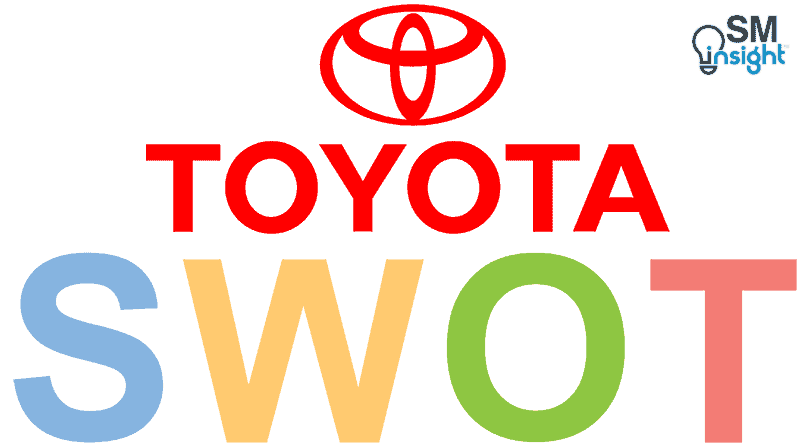This Toyota SWOT analysis reveals how one of the most innovative automotive companies used its competitive advantages to become the dominant player in the automotive industry.
It identifies all the key strengths, weaknesses, opportunities and threats that affect the company the most. If you want to find out more about the SWOT of Toyota, you’re in the right place.
For more information on how to do a SWOT analysis please refer to our article.
Keep reading.
Company Overview
| Name | Toyota Motor Corporation |
|---|---|
| Founded | August 28, 1937 |
| Logo |  |
| Industries served | Automotive, Housing, Financial Services, Other |
| Geographic areas served | Worldwide (over 170 countries) |
| Headquarters | Toyota, Aichi, Japan |
| Current CEO | Koji Sato |
| Revenue (US$) | 311.157 billion (2024) |
| Net Income (US$) | 34.120 billion (2024) |
| Employees | 380,793 (2024) |
| Main Competitors | Bayerische Motoren Werke AG, Chrysler Group LLC, Daimler AG, Ford Motor Co., Tesla, General Motors Company, Honda Motor Company, Nissan Motor, Tata Motors, Ltd., Volkswagen AG and many other automotive companies. |
Toyota Motor Corporation (further Toyota) is the world’s leading automaker (often tied with Volkswagen for 1st-2nd place) based in Toyota City, Japan. In 2012, the company was the first automotive company to produce over 10 million vehicles in a single year.
The company operates 4 different brands: Daihatsu, Hino, Lexus and Toyota. Toyota’s brand is the world’s 7th most valuable brand in the world and the most valuable automotive brand, worth US$50.291 billion.
The main Toyota’s markets are Japan, United States and China, where the company sells over 50% of its vehicles. The company produces the best-selling hybrid vehicle Prius.
You can find more information about the business in Toyota’s official website or Wikipedia’s article.
Toyota SWOT analysis
| Strengths | Weaknesses |
|---|---|
| 1. Strong focus on research and development (R&D) leading to some of the most innovative vehicles in the world 2. The most valuable and one of the most recognizable automotive brands 3. Toyota Production System 4. Competence in electrified vehicle production 5. Toyota environmental challenge 2050 6. Production of the most dependable cars in the industry | 1. Lack of competence in autonomous vehicles 2. Negative publicity due to large vehicle recalls damages company’s brand and sales 3. Weak presence in China lowers company’s future growth potential 4. Poor brand portfolio |
| Opportunities | Threats |
|---|---|
| 1. Future markets for self-driving vehicles 2. Significant untapped potential of Chinese, Indian and other Asian international markets 3. Improving U.S. economic conditions 4. Timing and frequency of new model releases | 1. Increasing competition in the worldwide automotive market 2. The automotive industry is subject to various governmental regulations 3. Potential economic and political volatility in international markets 4. Toyota may be adversely affected by natural disasters |
Strengths
1. Strong focus on research and development (R&D) leading to some of the most innovative vehicles in the world
Toyota is famous for its innovative culture. The company’s goal on being ahead of its competition by introducing some of the most innovative vehicles in the market has proven to be a successful strategy.
Toyota’s R&D initiatives, especially in producing environmentally friendly vehicle technologies, vehicle safety and information technology, provide it with some of the best strategic advantages.
The company operates one of the largest research facility network among the automotive companies to achieve the best possible results from its R&D expenditure. In total, 15 research facilities in 8 different countries, including Japan, United States, China, Thailand, Australia, Germany, France and Belgium, focus on 3 key R&D areas:[1]
- Basic research. This area researches basic vehicle technology.
- Forward-looking and leading-edge technology development. Development of newest technology and components that surpasses rivals’ technologies.
- Product development. New model development and upgrades for existing ones.
Toyota’s focus on innovation has resulted in one of the highest automotive R&D spending. Toyota’s R&D expenditures were approximately JP¥1.064.2 billion (US$9.613 billion) in fiscal 2018, ¥1,037.5 billion (US$9.579 billion) in fiscal 2017, and ¥1,055.6 billion (US$8.787 billion) in fiscal 2016.[1]
Figure 1. Toyota’s and its competitors R&D spending (US$ billions)
| Company | 2017 R&D | As a % of revenues | 2016 R&D | As a % of revenues |
|---|---|---|---|---|
| Toyota* | 9.613 | 3.6 | 9.579 | 3.8 |
| Ford | 8 | 5.1 | 7.3 | 4.8 |
| Volkswagen | 15.8 | 6.7 | 14.4 | 7.3 |
| General Motors | 7.3 | 5 | 8.1 | 4.9 |
Among the automotive companies, only Volkswagen spends more on R&D than Toyota. Nonetheless, Toyota uses its R&D budget the most effectively, spending just 3.6% of its total revenue on R&D, while Volkswagen spends 6.7%.
This means that Toyota needs to spend less on R&D to generate the same amount of revenue than its key rivals.
Huge, efficient R&D spending has allowed Toyota to gain a competitive advantage over its competitors and to become one of the largest automotive manufacturers in the world by researching and introducing the leading-edge technology and vehicles to the consumers.
2. The most valuable and one of the most recognizable automotive brands in the world
Toyota Motor Corporation was incorporated in 1937 and since then, has become one of the most recognizable brands in the world.
According to Interbrand[5] and Forbes[6], Toyota’s brand is the world’s 7th and 9th most valuable brand worth US$50.291 billion and US$44.7 billion, accordingly. In both lists, it is the most valuable brand out of all automotive companies.
Figure 2. Automotive brand ranking by Interbrand
| Ranking (Automotive) | Brand | Brand Value (in US$ billions) | Overall brand ranking in 2017 |
|---|---|---|---|
| 1 | Toyota | 50.291 | 7 |
| 2 | Mercedes-Benz | 47.829 | 9 |
| 3 | BMW | 41.521 | 13 |
| 4 | Honda | 22.696 | 20 |
| 5 | Ford | 13.643 | 33 |
| 6 | Hyundai | 13.193 | 35 |
| 7 | Audi | 12.023 | 38 |
| 8 | Nissan | 11.534 | 39 |
| 9 | Volkswagen | 11.525 | 40 |
| 10 | Porsche | 10.129 | 48 |
Brand value is closely related to brand reputation and recognition. Toyota, which produced and sold 8.964 million vehicles in 190 countries in 2018 alone, has one of the widest consumer reach in the world.
Manufacturing, research and sales operations worldwide, combined with a huge number or vehicles sold, as well as advertising spending has helped the company to create one of the most recognizable brands in the world. Brand recognition helps the company to introduce new products to the market more easily and with fewer costs.
Toyota brand is also one of the most reputable brands in the automotive industry. Over its 75 years’ history, the company received hundreds of awards accolades in vehicle design, safety, environment-friendliness and manufacturing operations.[7]
In 2018 alone, the company has received 7 IIHS (Insurance Institute for Highway Safety) Top Safety Picks 2018 awards (more than any other automotive company) for its Toyota Corolla, Prius, Camry, Avalon, Highlander and RAV4 vehicle models as well as 4 other Top Safety awards for Lexus models.[8]
The company received more 2017 J.D. Power Vehicle Dependability Awards than any other brand.[9] In addition to the awards for its vehicles, the company ranks the 2nd on the Carbon Clean 200 List, which ranks the companies according to their efforts to transition to clean energy.[10]
Toyota’s brand and recognition provides the company with a competitive edge over competitors as few other automotive brands are so well-known and reputable.
3. Toyota Production System
Toyota production system or TPS is a manufacturing system developed by Toyota. The system’s philosophy is to ‘eliminate all waste from manufacturing process’. The system was based on Just-in-Time concept. TPS has become very successful in allowing the company to increase production efficiency, decrease manufacturing time and simplify its processes. All of which resulted in lower costs and better quality vehicles.
Figure 3. Toyota Production System
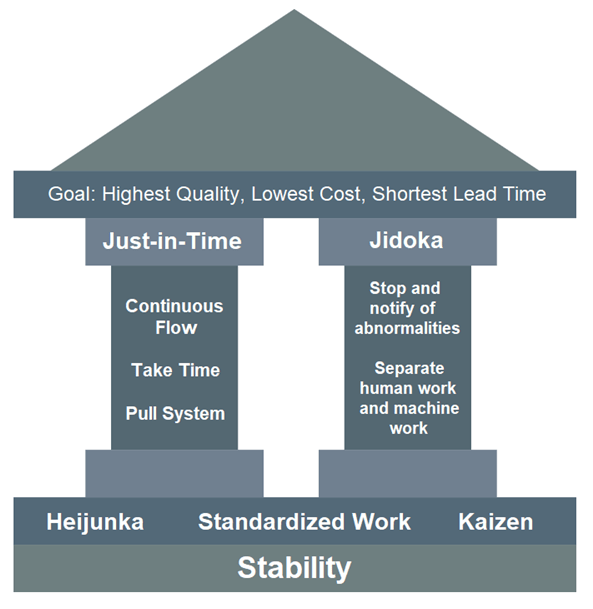
Due to the TPS, Toyota’s operating profit margin of 8.2% is the highest when compared to its largest competitors Volkswagen’s operating profit margin of 6% or General Motors’ operating profit margin of 6.2% (in 2016).
Figure 4. Toyota and its largest competitors’ operating profit margin comparison (in percentages)
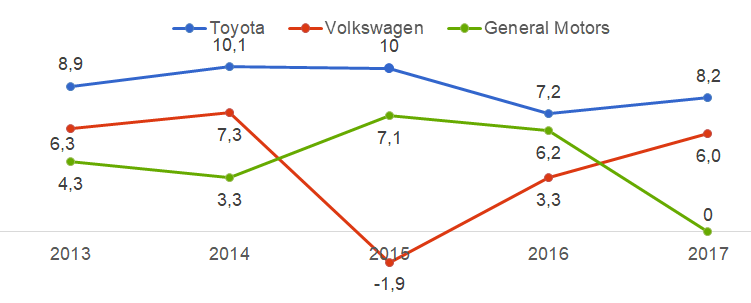
The graph shows that Toyota constantly enjoys higher operating profit margins than Volkswagen or General Motors. This means that costs of running the business are much lower for Toyota, which is most likely the result of the company’s production system.
Toyota’s production system is unique and is very hard to replicate. It is a strength few rivals can match.
4. Competence in electrified vehicle production
Toyota is heavily invested in its hybrid vehicle (HV) lineup and is betting its long-term future on HVs and electric HVs.
The company has introduced its first hybrid vehicle Toyota Prius in 1997. Prius became the first mass-produced hybrid vehicle and the most successful to date. By the end of 2017, the company has sold over 6.5 million Prius models, of which 457.4 thousand were sold in 2017 alone. Toyota’s total sales of electrified (mostly hybrid) vehicles were 1.521 million in 2017. Since 1997, the company has sold 11.471 million electrified vehicles, more than any other automotive company in the world.[12] The sales of Toyota’s electrified vehicles are growing faster every year.
Figure 5. Toyota’s sales of electrified vehicles in 2010-2017 (in thousands)
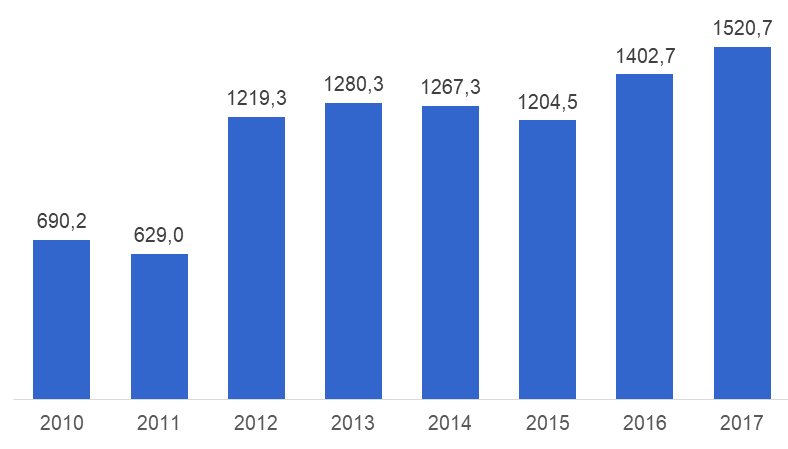
Currently, Toyota offers over 30 hybrid vehicles and plug-in hybrid vehicles under its four brands. Toyota’s HV technology is probably the best-in-class. It is proven by a 2017 Prius Eco model, which is the most fuel efficient car that doesn’t have a plug-in capability.
Figure 6. Toyota’s sales of electrified (mostly hybrid) vehicles by model in 2017
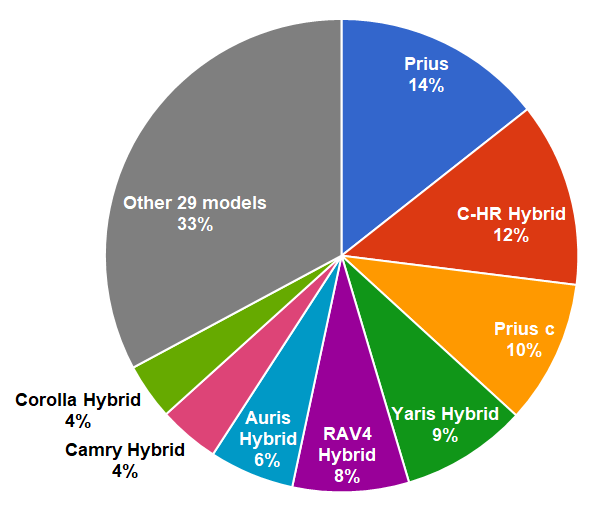
Toyota’s competence in hybrid vehicles is a long-term competitive advantage that its competitors will not be able to match in a near future.
5. Toyota environmental challenge 2050
In 2015, Toyota announced six environmental challenges that it hopes to achieve until 2050. Covering issues such as climate change and resource and water recycling, the challenges all involve formidable difficulties, but Toyota is committed to continuing with steady initiatives to achieve sustained development together with society.[1]
In its New Vehicle Zero CO2 Emissions Challenge, Toyota has set itself the target of achieving by 2050 a 90% reduction in new vehicle CO2 emissions compared to 2010. Towards this goal, Toyota will roll out the technology it has built up in the hybrid vehicle sector, adapting it to plug-in hybrid vehicles and to fuel cell and electric vehicles, which generate no CO2 emissions whatsoever. Toyota is committed to further accelerating its initiatives toward the development and widespread adoption of hybrid vehicles and other eco-cars.
The company’s clear strategy and past successes in achieving environmental challenges before the deadlines will help the company to strengthen its brand reputation, lower the environmental costs and will help to achieve compliance for government regulations earlier, which will ultimately result in more sales and higher profits.
6. Production of the most dependable cars in the industry
In 2018, a U.S. Vehicles Dependability Study (VDS) done by J.D. Power revealed that Toyota has some of the best industry’s ratings for vehicle dependability. The VDS measures the number of problems experienced per 100 vehicles during the past 12 months by original owners of 2015 model-year vehicles. The lower the score the better vehicle dependability.
Toyota’s Lexus was ranked as the most dependable brand among all automotive brands with only 99 problems per 100 vehicles. Toyota’s own brand ranked 9th with only 127 problems per 100 vehicles. Toyota Motor Corporation also won 6 out of 19 category awards, two for Toyota Tacoma and Toyota Prius and four for Lexus various models, more than any other automotive company.
Figure 7. J.D. Power 2018 Vehicles Dependability Study (problems per 100 vehicles)
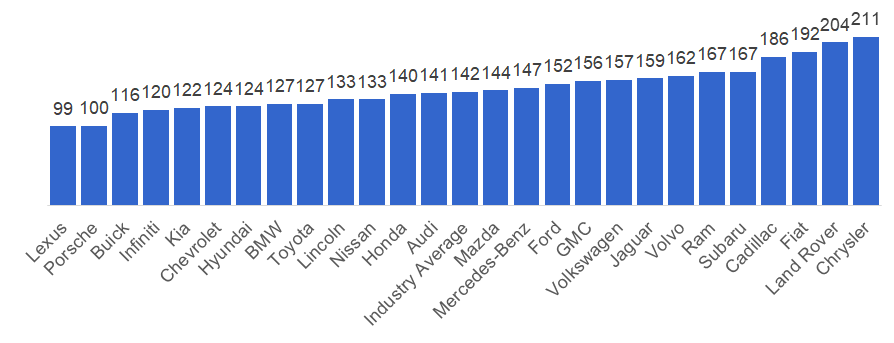
Weaknesses
1. Lack of competence in autonomous vehicles
Toyota has long been reluctant to invest in autonomous vehicle technology. The company has been engaged in R&D aimed at contributing to the complete elimination of traffic casualties, but the company had no plans to introduce completely autonomous vehicles in the near-future.[1]
The company’s first attempt to developing such technology was in 2015, through the Team Mobility concept, which aims to facilitate the connection between the car and its surroundings and between the car and the driver to assure safe and efficient driving. These initiatives were far behind rivals’ efforts on autonomous vehicles and Toyota had to step up.
In 2017, Toyota Research Institute introduced the first Toyota autonomous vehicle trials on roads. [14] In 2018, the company announced that it will invest US$2.8 billion into the new Toyota Research Institute-Advanced development company. The company will focus on developing software for artificial intelligence, which will be used for autonomous vehicles. [15]
Nonetheless, Toyota still lags behind its main competitors like General Motors, Volkswagen and Ford. Ford and General Motors were testing their first autonomous cars back in 2013.[16] In 2018, these companies have made more progress and have better technologies in developing fully autonomous cars. According to the research done by Navigant Research, Toyota’s strategy and execution in developing autonomous vehicles is worse than most of its rivals.[17]
Figure 8. Assessment of Strategy and Execution for 19 Companies Developing Automated Driving Systems
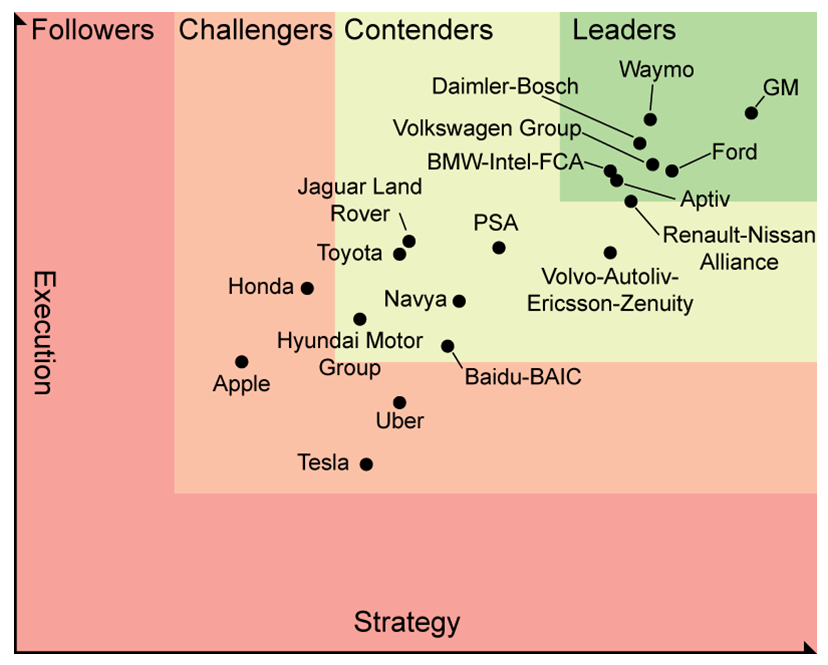
The company’s lack of technology and experience in building autonomous vehicles puts it at disadvantage against such competitors as General Motors, Ford and Volkswagen Group.
2. Negative publicity due to large vehicle recalls damages company’s brand and sales
Vehicle recalls affect every automaker. Toyota is no exception. While some automakers experience fewer recalls, other have to recall millions of vehicles each year. Toyota’s recall rates are very high and this draws more negative publicity than usual. In 2017 and 2018 (July) alone, the company has issued the following recalls:
- 2.9 million vehicles recalled in China, Japan and Oceania, due to faulty Takata airbags;
- 228,000 Tacoma vehicles recalled over an issue that could cause drivers to lose control of their cars;
- 300,000 Sienna vehicles sold in the U.S. were recalled because of safety concerns;
- 700,000 vehicles recalled in South Africa over faulty airbags;
- 74,000 pickups and SUVs were recalled over safety issues;
- 600,000 additional vehicles recalled in the U.S. over airbag issues;
- 115,000 Lexus cars recalled due to possible fuel leaks in engines.
These are only some of the biggest recalls issued by Toyota in 2017 and 2018. Large and frequent recalls negatively affect the company’s brand reputation and result in disappointed customers as well as fewer sales.
3. Weak presence in China lowers company’s future growth potential
China is the world’s largest automotive market and Toyota’s third largest market in terms of volume. The company currently sells 14.5% of its vehicles there. It isn’t the most profitable market for car manufacturers, but with 28.2 million vehicles sold in 2017, it dwarfs any other vehicle market, including the U.S.[1]
Toyota sold 1.3 million vehicles in China in 2017. The company sold 6% more units in 2017 when compared to 2016 (1.23 million units sold) and 16% more units when compared to 2015 (1.12 million units sold), but its market share increased only slightly from 4.5% in 2015 to 4.6% in 2017.[1]
Figure 9. Automotive companies’ market share in China
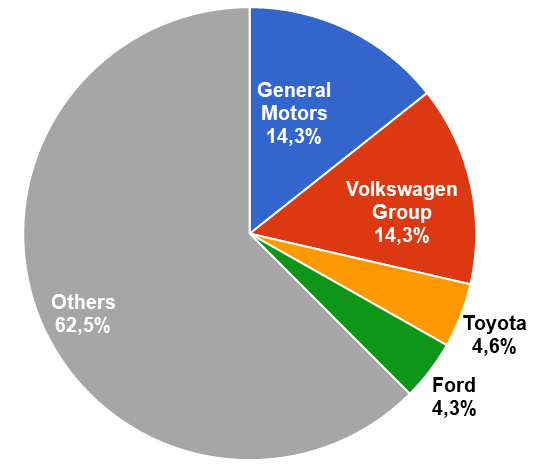
China is the largest vehicle market for the two main Toyota’s competitors, General Motors and Volkswagen where both companies sold 4.041 million vehicles and 4.020 million vehicles, and held 14.3% market share, respectively.
For any automotive company, China is a crucial market, if the company wants to succeed in the future. Toyota, which has a weak market share in China will find it hard to compete with General Motors and Volkswagen in the long run.
4. Poor brand portfolio
Toyota sells its vehicles under 4 different brands: Hino, Daihatsu, Lexus and Toyota. Toyota currently sells the majority of its vehicles under its own ‘Toyota’ brand, with top-end luxury cars being sold under its Lexus brand.[1] By comparison, some of its major competitors have a much larger brand portfolio, as illustrated below.
Figure 10. Brand portfolio of selected major Ford competitors
| Company | Brand portfolio |
|---|---|
| Toyota | Toyota, Lexus, Daihatsu, Hino |
| Ford | Ford, Lincoln |
| General Motors | Holden, Buick, Cadillac, Chevrolet, GMC, Opel, Vauxhall, Alpheon, Baojun, Jiefang and Wuling. |
| Volkswagen | Volkswagen, Audi, SEAT, Škoda, Bentley, Bugatti, Lamborghini, Porsche, Ducati, Volkswagen Commercial Vehicles, Scania, Man. |
While Toyota’s branding strategy assists with brand awareness and recognition (Toyota is the most valuable automotive brand in the world), there are several potential disadvantages to this approach. Toyota’s competitors with brand diversification (i.e. multiple brands) can more easily create a hierarchy for their vehicles in consumers’ minds, facilitating product differentiation. A brand diversification strategy can also minimize the fallout from any controversies that a vehicle manufacturer may experience.
A company like Toyota with their minimalist branding strategy is unlikely to be able to negate the negative publicity associated with product recalls, advertising scandals or vehicle failures.
With only a few brands, Toyota cannot target many different consumer segments and satisfy their various needs as well as Volkswagen or General Motors with their many brands.
Opportunities
1. Future markets for self-driving vehicles
The global demand for autonomous vehicles is growing fast, mainly due to the need to improve road safety, ease the driving experience and minimize traffic congestion in big cities. There are five main levels of vehicle automation:
Figure 11. Levels of automation in vehicles

At the moment, companies offer only level 2 automation vehicles for general consumers. According to Markets & Markets research[19], auto manufacturers produced only 2.73 million of these vehicles in 2016. Other research from Grand View Research reports that fully autonomous vehicles will be introduced to the market at a significant scale only in 2021-2022.[20]
In 2017, there were 44 companies working on autonomous vehicles, including Toyota.[21] While Toyota is one of the latest major automotive companies to start working on autonomous vehicles, the company expects to introduce vehicles with automated driving on highways by 2020 and vehicles with automated driving in urban areas in early 2020s.[1]
Even though the potential opportunity for autonomous vehicles is huge, there are still many challenges. It is yet to be determined what the potential market size would be, how effective the vehicles are, costs, and how they will be regulated in terms of safety concerns. For example, currently only 33 states in America permit driverless cars on the roads.[22] However, in terms of innovation and potential, the market for self-driving cars could potentially be very lucrative. It is an opportunity that automotive companies have no choice but to explore in the current competitive technological environment.
2. Significant untapped potential of Chinese, Indian and other Asian international markets
Along with many global automotive companies, Toyota has been capitalizing on China’s double digit economic growth for much of the past decade. Although this economic growth is slowing[23], China still represents a country of tremendous opportunity for automotive manufacturers, including Toyota. China’s middle class is growing on the back of its economic growth, and demand for motor vehicles is increasing accordingly.[24] The Chinese motor vehicle industry is currently the largest in the world. Toyota however only has a 4.6% market share in it.[1]
Toyota’s strategy to increase market share in China is to focus on introducing more hybrid and electric vehicles to comply with strict Chinese quotas over production and sales for new energy vehicles. With its strong brand reputation and increasing focus on research and development, Toyota is well-positioned to capitalize on this opportunity.
In India, Toyota similarly has a minimal market share of just 5%.[25] However the market is forecast to be the world’s third largest by 2020 behind China and the United States, on the back of a rising middle class population, many of whom will be able to afford cars for the first time.[26]
By 2030, Asia’s share of the world’s middle class population is predicted to double, from 30% to 60%. Much of this growth will be in China and India, but also in Indonesia, Vietnam, Thailand and Malaysia. In many of these countries, the average number of cars per household is well below the levels in Western countries.[27] These countries represent a significant opportunity for all automotive companies, including Toyota.
3. Improving U.S. economic conditions
North America is the largest Toyota’s geographic segment by vehicle unit sales. The company sells 31.3% of its vehicles in Mexico, Canada and the United States, combined. The company reveals that the U.S. accounts for 87% of the North America’s sales, which makes it the second most important Toyota’s market in terms of revenue, after Japan.
The outlook for the U.S. economy is positive[28], which is an opportunity for Toyota to consolidate and increase its already significant market share. Toyota currently has the 3rd largest market share in the U.S.
Figure 12. Market share of major competitors in the U.S. market
| Company | Market share (%) |
|---|---|
| General Motors | 17.41 |
| Ford Motor Company | 14.94 |
| Toyota Motor Corporation | 14.12 |
| FCA/Chrysler Group | 12.02 |
| Nissan Motor Company | 9.84 |
| Honda Motor Company | 9.52 |
| Others | 22.15 |
Unlike Ford or General Motors, Toyota does not rely as heavily on pickup trucks to generate the majority of its sales in the U.S., so the company has better opportunities grow its sales by offering smaller electrified passenger cars for the market.
4. Timing and frequency of new model releases
The market share of automotive companies is significantly impacted by the timing and frequency of new model releases, a fact that Toyota itself acknowledges.[1] Historically, new models have tended to have major upgrades every 4 or 5 years, with only minor modifications in between.
However, due to rising consumer expectations in relation to in-car technology and the competitive nature of the industry, there is an argument to release upgraded models more frequently. Toyota is well-positioned to be able to do this, with its current focus on R&D. The key will be its ability to cost effectively implement technology initiatives in order to maximize competitive advantage.
Threats
1. Increasing competition in the worldwide automotive market
The automotive industry is highly competitive, both in the Japan’s automotive market and in international markets around the world. Toyota’s international rivals such as Volkswagen and General Motors have aggressively taken market share from Toyota. Despite the fact that the worldwide automotive market is already highly competitive, the competition is further increasing due to the excess of vehicle production, rapid technological changes, new entrants and saturation of the largest markets. This competition may further increase with the potential future entry of Chinese and Indian rivals.
In international markets, particularly in growth regions such as China, there is a similar intensity of competition. This competition is fueled by the fact that global automotive production capacity far exceeds demand. In 2017, there was an estimated global excess production capacity of 35 million units.[2]
In addition to traditional automotive competitors, technology companies such as Google and Apple are showing interest in the automotive market, through initiatives such as the development of driverless vehicles and sophisticated in-car technology that is compatible with their devices and operating platforms.[30] This may give these organizations technological influence over future vehicle development, which automotive companies may not be able to control.
2. The automotive industry is subject to various governmental regulations
Increasing government regulations is one of the key threats affecting Toyota. The company has emphasized this issue in its financial report:
“The worldwide automotive industry is subject to various laws and governmental regulations including those related to environmental matters such as emission levels, fuel economy, noise and pollution. Toyota has incurred, and expects to incur in the future, significant costs in complying with these regulations.
Furthermore, new legislation or changes in existing legislation may also subject Toyota to additional expenses in the future. If Toyota incurs significant costs related to meeting laws and governmental regulations, Toyota’s financial condition and results of operations may be adversely affected.”[1]
3. Potential economic and political volatility in international markets
With Toyota currently generating 68.4% of its total revenue from outside of its home Japan market, the company is vulnerable to international economic and political conditions. Stricter local government regulations and/or import controls, rising interest rates as well as the outbreak of hostilities or acts of terrorism could all adversely affect Toyota’s operations internationally. Toyota acknowledges this risk in its most recent financial report:
“Each of the markets in which Toyota competes has been subject to considerable volatility in demand. Demand for vehicles depends to a large extent on economic, social and political conditions in a given market. As Toyota’s revenues are derived from sales in markets worldwide, economic conditions in such markets are particularly important to Toyota.”
“Toyota is subject to various risks associated with conducting business worldwide. These risks include natural calamities; political and economic instability. Should the major markets in which Toyota purchases materials, parts and components be affected by any of these events, it may result in disruptions and delays in the operations of Toyota’s business. Should significant or prolonged disruptions or delays related to Toyota’s business operations occur, it may adversely affect Toyota’s financial condition and results of operations.”[1]
4. Toyota may be adversely affected by natural disasters
Toyota and its suppliers have many manufacturing facilities in Japan, Thailand, China and Indonesia. These countries, are often affected by natural disasters, such as earthquakes, tsunamis and flooding. Every occurrence of such calamity may disrupt the manufacturing processes and result in supply shortages or an overall halt of the production.
In the past, Toyota’s operations have been significantly impacted by such disasters and resulted in huge losses. For as long as the company or its suppliers will continue to run their manufacturing in these or similarly affected countries, Toyota will be subject to further occurrences of natural disasters and huge losses.
Summary
Toyota has become one of the world’s largest automotive companies because of its innovative and quality vehicles that are also resonably priced. The company should further rely on its R&D capabilities, Toyota Production System and competence in electrified vehicles. These are the key Toyota’s strengths that should drive company’s growth in the future.
As for the weaknesses, Toyota has to really push forward on autonomous vehicles and increase its market share in China. Both weaknesses can significantly harm the company over the next 5-10 years.
Out of all the opportunities, future market growth of self-driving vehicles is the most significant one. Nonetheless, Toyota is behind its rivals in developing autonomous vehicles and the company may find it hard to get the most of this opportunity.
None of the threats immediatelly pose any danger for Toyota and the company is capable to prepare for them in the future or mitigate their potential damage.
Toyota will continue to successfully compete in the automotive market in the future.
Sources
- Toyota Motor Corporation (2018). Form 10-K for the Fiscal Year Ended March 31st, 2018. Available at: http://www.toyota-global.com/pages/contents/investors/ir_library/sec/pdf/20-F_201803_final.pdf Accessed July 16, 2018
- Ford Motor Company (2018). Form 10-K for the Fiscal Year Ended December 31st, 2017. Available at: http://shareholder.ford.com/~/media/Files/F/Ford-IR-V2/events-and-presentations/2018/F-2017-10-K-report.pdf Accessed July 16, 2018
- General Motors Company (2018). Form 10-K for the Fiscal Year Ended December 31st, 2017. Available at: http://www.gm.com/company/investors/sec-filings.html Accessed July 16, 2018
- Volkswagen AG (2018). Annual Report 2017. Available at: https://www.volkswagenag.com/presence/investorrelation/publications/annual-reports/2018/volkswagen/en/Y_2017_e.pdf Accessed July 16, 2018
- Interbrand (2018). Best Global Brands 2017. Available at: http://interbrand.com/best-brands/best-global-brands/2017/ranking/ Accessed July 16, 2018
- Forbes (2018). The World’s Most Valuable Brands. Available at: http://www.forbes.com/powerful-brands/list/ Accessed July 16, 2018
- Toyota Motor Corporation (2018). Award History. Available at: https://www.toyota-global.com/company/history_of_toyota/75years/data/automotive_business/products_technology/technology_development/award/index.html Accessed July 16, 2018
- Insurance Institute for Highway Safety (2018). Top Safety Picks by year. Available at: http://www.iihs.org/iihs/ratings/TSP-List Accessed July 16, 2018
- Toyota (2018). Toyota Awards & Ratings. Available at: https://www.toyota.com/awards/ Accessed July 16, 2018
- As You Sow (2018). Carbon Clean 200: Investing In A Clean Energy Future. Available at: https://www.asyousow.org/report/clean200-2018-q1 Accessed July 16, 2018
- Lean Enterprise Institute (2018). Toyota Production System. Available at: http://www.lean.org/lexicon/toyota-production-system Accessed July 16, 2018
- Toyota (2018). Toyota sells 1.52 million electrified vehicles in 2017, three years ahead of 2020 target. Available at: https://newsroom.toyota.co.jp/en/corporate/20966057.html Accessed July 16, 2018
- J.D. Power (2018). Most Owners Still in Love with Their Three-Year-Old Vehicles, J.D. Power Finds. Available at: http://www.jdpower.com/press-releases/jd-power-2018-us-vehicle-dependability-study Accessed July 16, 2018
- Iliff, L. (2017). Toyota says its ‘in the game’ on autonomous technology. Available at: http://www.autonews.com/article/20171023/MOBILITY/171029940/toyota-autonomous-vehicle-testing-tri Accessed July 16, 2018
- O’Kane, S. (2018). Toyota starts a new $2.8 billion company to develop self-driving software. Available at: https://www.theverge.com/2018/3/2/17070828/toyota-research-institute-tri-ad-tokyo Accessed July 16, 2018
- Dormehl, L. and Edelstein, S. (2018). Sit back, relax, and enjoy a ride through the history of self-driving cars. Available at: https://www.digitaltrends.com/cars/history-of-self-driving-cars-milestones/ Accessed July 16, 2018
- Navigant Research (2018). Navigant Research Leaderboard: Automated Driving Vehicles. Available at: https://www.navigantresearch.com/research/navigant-research-leaderboard-automated-driving-vehicles Accessed July 16, 2018
- BMW Group (2016). Annual Report 2016. Available at: https://www.bmwgroup.com/content/dam/bmw-group-websites/bmwgroup_com/ir/downloads/en/2015/12784_GB_2015_engl_Finanzbericht_Online.pdf Accessed July 16, 2018
- Research and Markets (2017). Global Autonomous Vehicles Market – Analysis & Forecast (2016-2025). Available at: http://www.researchandmarkets.com/research/wd2lrs/global_autonomous Accessed July 16, 2018
- Grand View Research (2017). Autonomous Cars/Driverless Cars Market Analysis and Segment Forecasts To 2024. Available at: http://www.grandviewresearch.com/industry-analysis/driverless-cars-market Accessed July 16, 2018
- CB Insights (2017). 44 Corporations Working On Autonomous Vehicles. Available at: https://www.cbinsights.com/blog/autonomous-driverless-vehicles-corporations-list/ Accessed July 16, 2018
- National Conference of State Legislature (2018). Autonomous Vehicles | Self-Driving Vehicles Enacted. Available at: http://www.ncsl.org/research/transportation/autonomous-vehicles-self-driving-vehicles-enacted-legislation.aspx Accessed July 16, 2018
- Trading Economics (2018). China GDP Annual Growth Rate. Available at: http://www.tradingeconomics.com/china/gdp-growth-annual Accessed July 16, 2018
- McCaffrey, C. R. and Peterson, E. R. (2018). The Rise of China’s Middle-Class Consumer. Available at: https://www.atkearney.com/diversity-and-inclusion/article/-/asset_publisher/O7EGSazwBWC9/content/the-rise-of-china-s-middle-class-consumer-article/236833 Accessed July 16, 2018
- Shah, R. (2018). Top-10 carmakers in India and their market share: Maruti Suzuki owns half of the Indian market. Available at: https://www.financialexpress.com/auto/car-news/top-10-carmakers-in-india-and-their-market-share-maruti-suzuki-owns-half-of-the-indian-market/1129193/ Accessed July 16, 2018
- Karnik, M. (2016). 600 million people are now part of India’s middle class—including your local carpenter. Available at: https://qz.com/742986/600-million-people-are-now-part-of-indias-middle-class-including-your-local-carpenter/ Accessed July 16, 2018
- Roughneen, S. and Asia, N. (2017) Booming Southeast Asian vehicle sales drive urban congestion. Available at: https://www.ft.com/content/96608536-4204-11e7-9d56-25f963e998b2 Accessed July 16, 2018
- Trading Economics (2018). United States GDP Growth Rate. Available at: http://www.tradingeconomics.com/united-states/gdp-growth Accessed July 16, 2018
- Matthews, J. (2018). U.S. Auto Sales Brand Rankings – December 2017 YTD. Available at: http://www.goodcarbadcar.net/2018/01/u-s-auto-sales-brand-rankings-december-2017-ytd/ Accessed July 16, 2018
- Greenough, J. (2017). How Tech Companies Will Win the Battle Over the Connected Car’s Digital Dashboard. Available at: http://www.businessinsider.com.au/how-tech-companies-will-win-the-battle-over-the-connected-cars-digital-dashboard-2015-12 Accessed July 16, 2018

